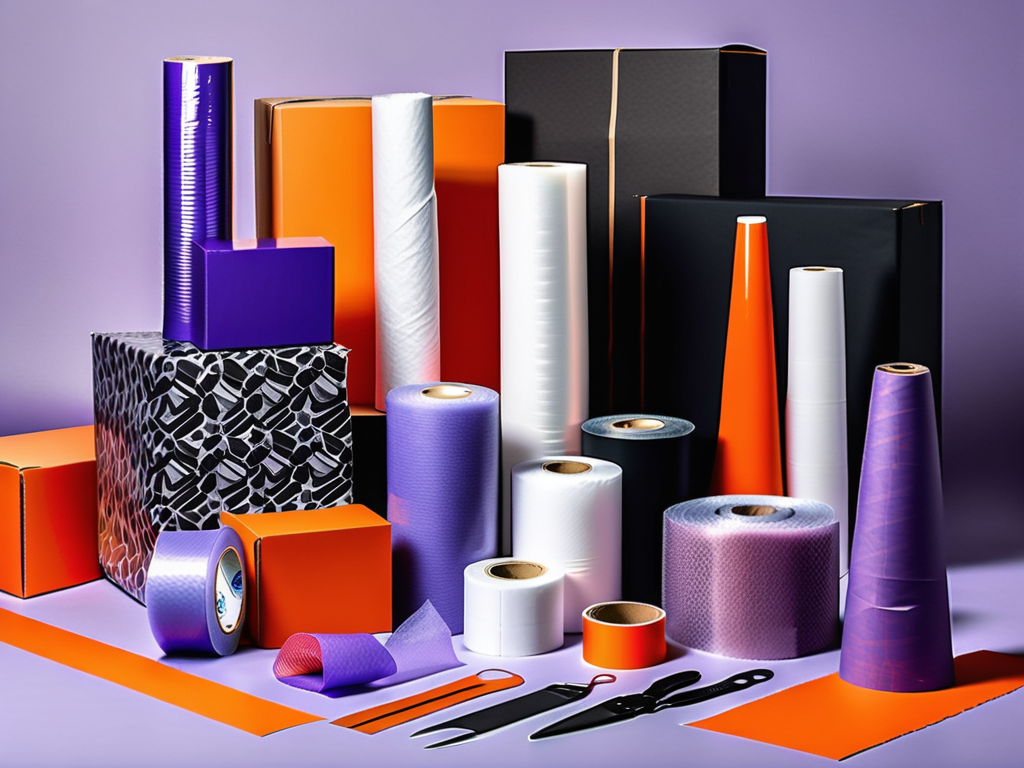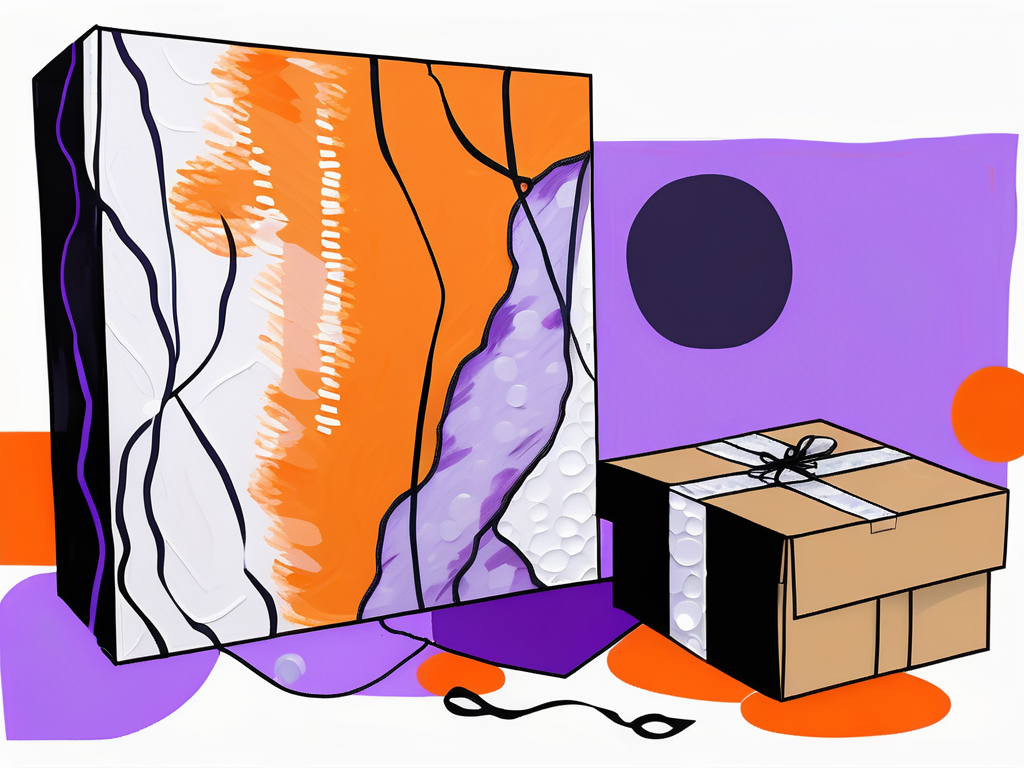Did you know that improper packaging is one of the leading causes of damage to artwork during shipping? Whether you’re sending a painting to a buyer, shipping it to a gallery, or moving it to a new location, proper packaging is crucial to ensure its safety during transit.
In this article, we will guide you through:
- The process of packaging a painting for shipping, step-by-step
- Materials Needed for Packaging Paintings
- Special Considerations for Different Types of Paintings
So, let’s dive in and discover the art of protecting artworks in transit.
Table of Contents
TogglePackaging a Painting for Shipping: The Full Process
To package a painting for shipping, carefully wrap it in acid-free paper, cushion it with bubble wrap, place it in a sturdy cardboard box, and secure it with packing tape to ensure safe transit. Follow these detailed guidelines to ensure your artwork stays safe on its journey.
Preparing the Painting for Packaging
The first step is to prepare the painting before placing it in the packaging. Here’s what you need to do:
- Remove any existing packaging: If the artwork already has packaging, carefully remove it to start with a clean slate.
- Clean the painting: Use a soft, lint-free cloth to gently remove any dust or dirt from the surface of the painting. This will prevent any particles from scratching the artwork during transit.
- Protect the corners: Attach cardboard corner protectors to each corner of the painting. These will absorb impacts and prevent damage to the fragile edges.
Now that you’ve taken the necessary steps to prepare your painting, let’s dive into the next phase of the packaging process.
Wrapping the Painting
Once the painting is prepared, it’s time to wrap it for added protection. Follow these steps:
- Wrap the painting in acid-free glassine paper: This archival-grade paper creates a barrier that protects the painting’s surface from direct contact with the protective materials.
- Cover the painting with bubble wrap: Wrap the painting gently but firmly with bubble wrap. Ensure that all corners and edges are well-padded for maximum protection.
- Secure the bubble wrap with stretch wrap: Use stretch wrap to tightly secure the bubble wrap around the painting. This will prevent any movement or unwrapping during transit.
By taking these additional steps to wrap your painting, you’re adding an extra layer of security to keep your artwork safe during its journey.
Securing the Painting in the Box
Now that the painting is well-wrapped, it’s time to place it securely in the box:
- Prepare the box: Fill the bottom of the cardboard box with padding materials, such as foam or packing peanuts, to create a cushioned base.
- Place the painting inside the box: Carefully place the wrapped painting in the box, ensuring it sits snugly on the padding materials.
- Add more padding: Fill any gaps between the painting and the sides of the box with additional padding materials. This will prevent the painting from shifting during transit.
Properly securing your painting within the box is crucial to its safe arrival. Taking the time to add extra padding will provide an added layer of protection against any potential bumps or jostling during shipping.
Final Steps Before Shipping
Before sealing the box and sending your painting on its way, complete these final steps:
- Securely seal the box: Use packing tape to seal all edges of the box, ensuring it is tightly closed.
- Label the package: Clearly label the package with the recipient’s address, your return address, and any additional instructions or warnings.
- Attach fragile stickers: Place fragile stickers on all sides of the box, drawing attention to the fragile nature of its contents.
These final steps are essential to ensure that your painting is handled with care throughout its journey. By clearly labeling the package and adding fragile stickers, you’re alerting the shipping personnel to handle your artwork delicately.
Now that you have a comprehensive understanding of the step-by-step process of packaging a painting, you can confidently prepare your artwork for shipping. Remember, taking the time to properly package your painting will provide peace of mind and ensure its safe arrival at its destination.
Understanding the Importance of Proper Packaging
Packaging your painting properly is more than just placing it in a box and sealing it. It involves using the right materials and techniques to minimize the risks of damage during transportation. Let’s take a closer look at why proper packaging is so important.
When it comes to shipping your precious artwork, the risks of improper packaging are not to be taken lightly. Without adequate protection, your painting may face a myriad of dangers during its journey to its destination. Let’s explore some of these risks in more detail:
- Falls and impacts: Picture this: your painting is being tossed around in the back of a delivery truck, unprotected and vulnerable. Without proper padding and support, it may experience jolts and shocks during transport, leading to cracks, dents, or even complete destruction. The thought alone is enough to make any art enthusiast cringe.
- Temperature and humidity fluctuations: Art is sensitive, and your painting is no exception. Extreme temperature changes or exposure to high humidity can cause warping, color fading, or even worse, mold growth on the painting’s surface. Imagine the disappointment of receiving a once vibrant masterpiece, now marred by the effects of improper packaging.
- Moisture damage: Water is an artwork’s worst enemy. If the painting is not adequately sealed or protected from moisture, water can seep into the packaging and wreak havoc on the delicate canvas or paper. The result? Irreversible damage that could have been prevented with proper packaging.
On the other hand, when you take the time and effort to package your painting correctly, you can enjoy a multitude of benefits that will put your mind at ease:
- Peace of mind: Proper packaging will give you the confidence that your artwork is secure and well-protected, allowing you to focus on other aspects of the shipping process. No more worrying about the safety of your masterpiece while it’s in transit.
- Preservation of value: As an art lover, you understand the value of your painting goes beyond its monetary worth. By packaging your painting correctly, you are taking the necessary steps to maintain its condition and preserve its value. Ensuring that it arrives at its destination in the same state it was sent is a testament to your dedication as a responsible art owner.
- Customer satisfaction: Whether you’re shipping your artwork to a buyer or sending it as a gift, ensuring its safe arrival is paramount. By packaging your painting properly and protecting it from potential damage, you can provide a positive experience for your buyers or recipients. This not only increases their satisfaction but also enhances the likelihood of repeat business and positive word-of-mouth recommendations.
So, the next time you find yourself preparing to ship a painting, remember the importance of proper packaging. It’s not just about protecting your investment; it’s about preserving the beauty and integrity of art for generations to come.
Materials Needed for Packaging Paintings
Now that you understand the importance of proper packaging, let’s gather the necessary materials to ensure your painting is well-protected during transit.

When it comes to packaging paintings, you can never be too cautious. The right materials will not only safeguard your artwork but also provide peace of mind. Let’s dive into the details and explore the additional protective materials you can consider.
Protective Materials
For optimal protection, you’ll need the following protective materials:
- Bubble wrap: Use bubble wrap to cushion the painting and protect it from shocks and vibrations. This lightweight material is designed to absorb impacts, ensuring your artwork remains unharmed.
- Cardboard corner protectors: These will help safeguard the corners of the painting from impacts. By adding an extra layer of protection to the most vulnerable areas, you can minimize the risk of damage during transit.
- Padding materials: Foam, packing peanuts, or similar materials can be used to fill any gaps inside the packaging and provide additional cushioning. These materials act as a buffer, preventing any movement within the box and keeping your painting secure.
- Stretch wrap: This plastic film can be used to wrap the entire painting, securing the protective materials in place. By tightly wrapping your artwork, you create a barrier that keeps everything intact, even if the box experiences rough handling.
Sturdy Boxes and Containers
The right box or container is crucial for protecting your painting. Here’s what you’ll need:
- Double-walled cardboard box: A double-walled box provides extra strength and protection during shipping. With its reinforced structure, it can withstand external pressure and minimize the risk of any damage reaching your precious artwork.
- Custom-sized box: Choose a box that closely fits the dimensions of your painting to eliminate unnecessary movements. A snug fit reduces the chances of your artwork shifting within the box, ensuring it remains in its intended position throughout the journey.
Sealing and Labeling Supplies
Finally, make sure you have the necessary supplies to seal and label the package:
- Tape: Use strong packing tape to seal the box and secure all edges. Opt for a tape that is specifically designed for shipping purposes, as it offers superior adhesion and durability.
- Permanent markers: These will come in handy for labeling the package with important information. Clearly mark the box with your name, address, and contact details to ensure smooth delivery.
- Fragile stickers: Adding fragile stickers to the package will alert handlers to take extra care during transport. These eye-catching labels act as a visual reminder for everyone involved in the shipping process, emphasizing the delicate nature of the contents.
By gathering these additional protective materials, you can enhance the safety measures for your artwork and minimize the risk of any mishaps during transit. Remember, investing in proper packaging is an investment in the preservation of your valuable paintings.
Special Considerations for Different Types of Paintings
While the general packaging process applies to most paintings, there are specific considerations for different types of artworks. Let’s explore these considerations:

Packaging Oil Paintings
Oil paintings require extra care due to the nature of the materials used. Here are a few additional steps to follow:
- Allow ample drying time: Ensure that the oil painting has had enough time to dry completely before packaging it.
- Use acid-free paper: Instead of glassine paper, use acid-free paper to wrap oil paintings. This will prevent any potential reactions between the oil paint and the paper.
Packaging Acrylic Paintings
Acrylic paintings are generally less delicate than oil paintings, but still require proper packaging to avoid damage. Consider the following:
- Protect the surface: Place a sheet of glassine paper or a protective plastic sheet over the painted surface to prevent any accidental smudging or sticking.
- Ensure complete drying: Make sure the acrylic paint has fully dried before packaging the painting to avoid any smearing or damage.
Packaging Watercolor Paintings
Watercolor paintings are highly susceptible to moisture damage and need special attention. Here’s what to keep in mind:
- Use glassine paper: Wrap watercolor paintings in glassine paper to protect the delicate pigment layers from smudging or running.
- Avoid direct contact: Place a sheet of acid-free tissue paper between the painting and the protective wrap to prevent the colors from transferring or blending.
Reduce the Shipping Costs of Paintings With Proper Packaging
By following the proper packaging techniques outlined in this article, you can significantly reduce the risks of damage to your paintings during shipping. Remember to choose the right materials, wrap the artwork securely, and provide ample cushioning inside the box.
Additionally, consider the specific requirements for different types of paintings to ensure their safety. By taking these precautions, you can have peace of mind knowing that your valued artworks will reach their destination unharmed and ready to brighten someone’s day.






